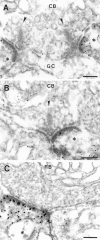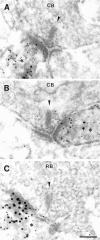Selective synaptic distribution of kainate receptor subunits in the two plexiform layers of the rat retina
- PMID: 9364075
- PMCID: PMC6573580
- DOI: 10.1523/JNEUROSCI.17-23-09298.1997
Selective synaptic distribution of kainate receptor subunits in the two plexiform layers of the rat retina
Abstract
The synaptic localization of the kainate receptor subunits GluR6/7 and KA2 and of the ionotropic glutamate receptor subunits delta1/2 was studied in the rat retina using receptor-specific antisera. GluR6/7 and KA2 were present in both synaptic layers of the retina: the inner plexiform layer (IPL) and the outer plexiform layer (OPL). The localization of delta1/2 was restricted to the IPL. Detailed ultrastructural examination showed that in the OPL GluR6/7 was localized in horizontal cell processes postsynaptic to both rod spherules and cone pedicles. It was always only one of the two invaginating horizontal cell processes at the photoreceptor synapses labeled for GluR6/7. KA2 in the OPL was found only postsynaptic to cone pedicles and never postsynaptic to rod spherules. The KA2-labeled processes made flat contacts with the cone pedicles, suggesting they are the dendrites of OFF bipolar cells. In the IPL the different receptor subunits were localized postsynaptically to ribbon synapses of both rod and cone bipolar cells. As a rule, only one of the two postsynaptic elements at the bipolar cell dyad was stained for each of the receptor subunits examined. The selective and heterogeneous distribution of these receptors at the ribbon synapses of the OPL and IPL suggests a high degree of differential processing of the glutamatergic signals.
Figures







Similar articles
-
Localization of kainate receptors at the cone pedicles of the primate retina.J Comp Neurol. 2001 Aug 6;436(4):471-86. doi: 10.1002/cne.1081. J Comp Neurol. 2001. PMID: 11447590
-
Development of glutamatergic synapses in the rat retina: the postnatal expression of ionotropic glutamate receptor subunits.Vis Neurosci. 2002 Jan-Feb;19(1):1-13. doi: 10.1017/s0952523801191017. Vis Neurosci. 2002. PMID: 12180854
-
Immunocytochemical localization of kainate-selective glutamate receptor subunits GluR5, GluR6, and GluR7 in the cat retina.Brain Res. 2001 Feb 2;890(2):211-21. doi: 10.1016/s0006-8993(00)03162-0. Brain Res. 2001. PMID: 11164787
-
Selective synaptic distribution of AMPA and kainate receptor subunits in the outer plexiform layer of the carp retina.J Comp Neurol. 2001 Jul 9;435(4):433-49. doi: 10.1002/cne.1042. J Comp Neurol. 2001. PMID: 11406824
-
The neuronal organization of the outer plexiform layer of the primate retina.Int Rev Cytol. 1984;86:285-320. doi: 10.1016/s0074-7696(08)60181-3. Int Rev Cytol. 1984. PMID: 6368448 Review.
Cited by
-
Modulation of the intracellular calcium concentration in photoreceptor terminals by a presynaptic metabotropic glutamate receptor.Proc Natl Acad Sci U S A. 1999 Aug 17;96(17):9909-14. doi: 10.1073/pnas.96.17.9909. Proc Natl Acad Sci U S A. 1999. PMID: 10449793 Free PMC article.
-
Immunohistochemical identification and synaptic inputs to the diffuse bipolar cell type DB1 in macaque retina.J Comp Neurol. 2011 Dec 15;519(18):3640-56. doi: 10.1002/cne.22756. J Comp Neurol. 2011. PMID: 22006647 Free PMC article.
-
Functional architecture of the retina: development and disease.Prog Retin Eye Res. 2014 Sep;42:44-84. doi: 10.1016/j.preteyeres.2014.06.003. Epub 2014 Jun 28. Prog Retin Eye Res. 2014. PMID: 24984227 Free PMC article. Review.
-
GRID1/GluD1 homozygous variants linked to intellectual disability and spastic paraplegia impair mGlu1/5 receptor signaling and excitatory synapses.Mol Psychiatry. 2024 Apr;29(4):1205-1215. doi: 10.1038/s41380-024-02469-w. Epub 2024 Feb 28. Mol Psychiatry. 2024. PMID: 38418578 Free PMC article.
-
Cell-specific cre recombinase expression allows selective ablation of glutamate receptors from mouse horizontal cells.PLoS One. 2013 Dec 12;8(12):e83076. doi: 10.1371/journal.pone.0083076. eCollection 2013. PLoS One. 2013. PMID: 24349437 Free PMC article.
References
-
- Araki K, Meguro H, Kushiya E, Takayama C, Inoue Y, Mishina M. Selective expression of the glutamate receptor channel delta 2 subunit in cerebellar Purkinje cells. Biochem Biophys Res Commun. 1993;197:1267–1276. - PubMed
-
- Bettler B, Egebjerg J, Sharma G, Pecht G, Hermans-Borgmeyer I, Moll C, Stevens CF, Heinemann S. Cloning of a putative glutamate receptor: a low affinity kainate-binding subunit. Neuron. 1992;8:257–265. - PubMed
-
- Boycott BB. Horizontal cells of mammalian retinae. Neurosci Res [Suppl] 1988;8:97–111. - PubMed
-
- Brandstätter JH, Hartveit E, Sassoè-Pognetto M, Wässle H. Expression of NMDA and high-affinity kainate receptor subunit mRNAs in the adult rat retina. Eur J Neurosci. 1994;6:1100–1112. - PubMed
Publication types
MeSH terms
Substances
LinkOut - more resources
Full Text Sources
Research Materials
